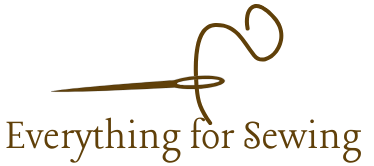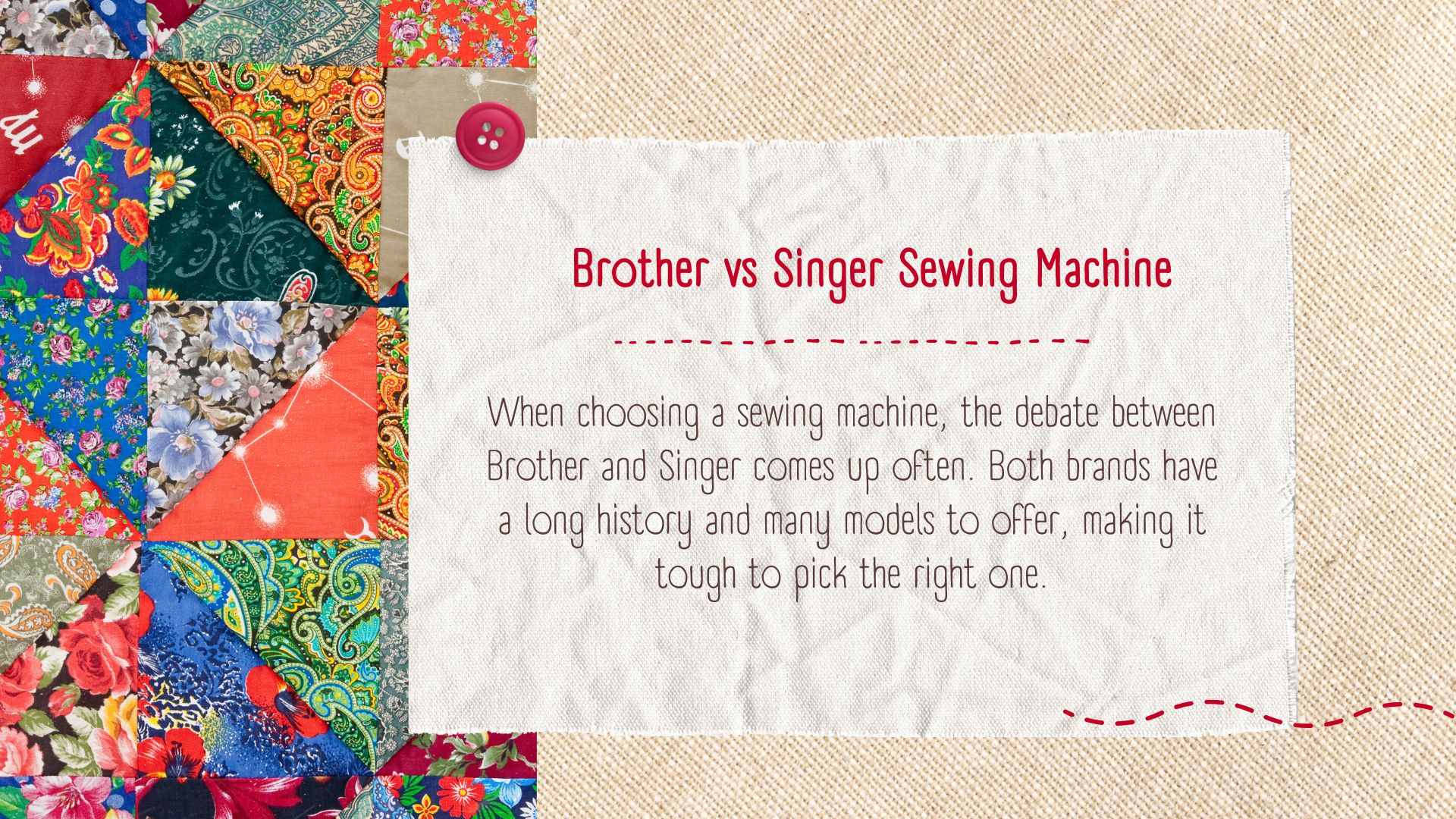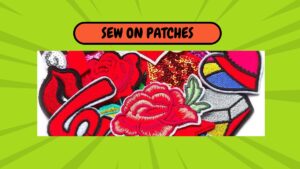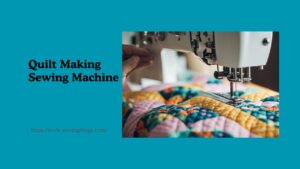When choosing a sewing machine, the debate between Brother and Singer comes up often. Both brands have a long history and many models to offer, making it tough to pick the right one.
If you want a balance of affordability and features, Brother machines might be the better choice for beginners, while Singer is a great option for those seeking reliable, mechanical models.

As I researched the differences, I found that Brother machines are known for their computerized options, which can add extra convenience and versatility.
On the other hand, Singer sticks to traditional designs that have proven reliable over time. Whichever brand you lean toward, each has its strengths that cater to different needs.
I want to help you navigate this choice so you can find the machine that fits your sewing style and budget perfectly.
Let’s dive deeper into what makes each brand unique and discover which one suits you best!
Contents
- 1 Table of Contents
- 2 History of Brother vs Singer Sewing Machines
- 3 Comparing Brother vs Singer Sewing Machines
- 4 Popular Models from Brother and Singer
- 5 Target Audience and Market Focus
- 6 Performance in Stitching and Embroidery
- 7 Support and After-Sales Service
- 8 Accessories and Customization Options
- 9 Price Comparison and Value for Money
- 10 Environmental Sustainability and Brand Values
- 11 Final Verdict on Brother vs. Singer
Table of Contents
History of Brother vs Singer Sewing Machines

Both Brother and Singer have rich histories in the sewing machine industry. These companies have evolved over the years, becoming popular choices among sewists for their quality and innovation.
Origins of Brother
Brother Industries was founded in 1908 in Japan. Initially, it was a small manufacturing company that produced sewing machines.
The first machine, called the “Brother M-1,” was released in 1928. It quickly gained popularity due to its durable design and ease of use.
In the following decades, Brother expanded its product line. They began to include more advanced models that featured various sewing functions. This made their machines accessible to beginners and experts alike.
By the 1960s, Brother was a well-known name worldwide, recognized for quality sewing machines.
Evolution of Singer
Singer Corporation has a longer history, dating back to 1851 when Isaac Merritt Singer founded the company in the United States.
The introduction of the first practical sewing machine revolutionized the craft. Singer’s machines allowed people to sew faster and more efficiently.
Over the years, Singer continued to innovate. They introduced electric sewing machines in the 1920s, which made sewing even easier.
Singer also focused on creating machines for various uses, from home sewing to industrial applications. By the mid-20th century, Singer had become synonymous with sewing machines, valued for their reliability and performance.
Comparing Brother vs Singer Sewing Machines
When I look at Brother vs Singer sewing machines, I see that both brands offer unique strengths. They cater to different needs and preferences, making it essential to understand their features to find the right fit.
Build Quality and Durability
In terms of build quality, each brand has its strengths.
Singer machines often have a reputation for being sturdy and durable. Their all-metal frames support heavy use, especially in projects like upholstery.
On the other hand, Brother machines, while also reliable, tend to have more plastic components. These can make them lighter but sometimes less durable in tough sewing situations.
Singer models like the Singer 4411 Heavy Duty offer solid construction meant for extensive projects.
Brother also has robust options, like the Brother ST371HD, which combines strength with a user-friendly design. Ultimately, durability can depend on how you plan to use the machine.
Range of Models and Features
Both brands offer a wide range of models suited for various skill levels.
Singer has models like the Singer 9960 with 600 built-in stitches, perfect for creative projects. They also include convenient features like an automatic needle threader.
Brother prides itself on modern technology. Their machines often come with LCD screens and a variety of built-in stitches.
For example, the Brother SE600 has 103 stitches and 80 embroidery designs. This variety allows me to choose based on my specific needs, whether I’m a beginner or more advanced sewist.
Ease of Use and User Experience
User experience can vary significantly between these two brands.
I find that Brother machines tend to focus on user-friendly features. Many models come with automatic needle threaders and easy-to-follow instructions, which are great for beginners.
Singer, while also offering straightforward machines, might require a bit more familiarity, especially with their advanced models.
The Singer 4411 is known for its power but may feel complex to a first-time user. Both brands have their strengths in ease of use, but I appreciate Brother’s approach for those just starting their sewing journey.
Popular Models from Brother and Singer
When choosing a sewing machine, it’s good to know the popular models from both Brother and Singer. Each brand offers unique features that cater to different sewing needs, making it easier for me to find the perfect match.
Brother’s Signature Machines
Brother has a variety of models that stand out for their reliability and features. One popular choice is the Brother SE600, which combines sewing and embroidery capabilities. It has a color touchscreen and allows me to import designs easily.
Another impressive model is the Brother CS5055PRW. It comes with 50 built-in stitches, making it great for various projects. The machine also features a lightweight design, which is useful for portability.
Lastly, there’s the Brother PQ1500SL, perfect for quilting. It has a high sewing speed and offers a large work area, making it suitable for tackling larger projects with ease.
Singer’s Top-Rated Models
Singer also has some fantastic machines worth considering. One of the best is the Singer 4423 Heavy Duty, known for its strong motor and ability to sew through thick fabrics. It includes 23 built-in stitches and a straightforward threading system, making it user-friendly.
Another great option is the Singer 9960 Quantum Stylist. This machine shines with its 600 built-in stitches and advanced features like mirror imaging. It’s perfect for those who enjoy experimenting with various styles.
Finally, the Singer Start 1304 is an excellent choice for beginners. It is simple to use, with six built-in stitches and a lightweight design, making it easy to transport. Each of these models offers something unique, helping me pick the right sewing machine for my needs.
Target Audience and Market Focus

When choosing between Brother vs Singer sewing machines, understanding their target audiences and market strategies is essential. Each brand appeals to different types of users based on skill level, sewing needs, and budget.
Brother’s User Demographics
I see that Brother sewing machines attract a wide range of users, from beginners to advanced sewers.
Their user-friendly features make them popular among hobbyists and those new to sewing.
Many crafters love Brother for its affordable models that provide good quality. The brand also offers computerized models, which appeal to tech-savvy users looking for advanced stitching options.
In addition to home sewers, Brother markets its machines to small business owners. Their heavy-duty models cater to users who need reliable machines for frequent use.
Singer’s Positioning in the Market
Singer has a strong reputation in the sewing community, known for durability and reliability.
I find that their machines often target more traditional sewers who value craftsmanship.
The brand’s variety includes entry-level models and heavy-duty machines, making it flexible for different skill levels.
Singer focuses on quality and sturdiness, appealing to those looking to invest in a long-lasting machine.
Performance in Stitching and Embroidery

When comparing the performance of Brother vs Singer sewing machines, it’s important to consider their distinct strengths in stitching and embroidery. Each brand offers unique features that cater to various sewing needs, making my choice based on what I prefer to create.
Stitching Capabilities of Brother
Brother machines are known for their versatility in stitching.
Many models come with a wide selection of built-in stitches, often exceeding 100 options. This allows me to tackle everything from basic repairs to decorative projects.
The Brother CS6000i, for instance, excels in speed and ease of use. It can reach up to 850 stitches per minute, making my sewing tasks faster without compromising quality.
Also, its automatic needle threader saves me time when changing threads.
Another strong point is the machine’s ability to work with various fabrics.
Whether I’m using lightweight cotton or heavier materials, I find that Brother machines handle different textures well, producing neat and even stitches.
Embroidery Features of Singer
Singer machines are often recognized for their robust embroidery capabilities.
For example, the Singer SEQS-6700 has features tailored for embroidery enthusiasts.
With a spacious work area, it accommodates larger projects, which is a huge plus when I want to create intricate designs.
Singer’s embroidery machines also include pre-programmed designs, which I find handy.
This feature lets me start my projects right away without needing to create every design from scratch.
Additionally, many models offer editing capabilities that let me adjust patterns to fit my needs.
The speed of embroidery on some Singer machines can reach 860 stitches per minute. This makes completing larger embroidery projects much quicker. In my experience, the stitch quality remains impressive, ensuring each design looks professional.
Support and After-Sales Service

When choosing between Brother vs Singer sewing machines, support and after-sales service are key factors.
Both brands have their strengths in warranty offerings and customer support structures.
Here’s what I found out about each one.
Warranty and Customer Support from Brother
Brother offers a solid warranty to buyers, typically ranging from 25 years to a limited one-year warranty on parts and labor.
This long warranty period shows confidence in their products and provides peace of mind for me as a buyer.
In addition to warranty coverage, Brother’s customer support is quite comprehensive.
They provide various resources, including online manuals, video tutorials, and troubleshooting guides, making it easy for new users like me to solve issues quickly.
Their support team is also reachable via phone and email for any specific questions.
Singer’s Service Network and Reliability
Singer also offers a competitive warranty, usually up to 25 years on mechanical parts, with coverage for one year on labor for repairs.
This gives me reassurance when investing in their machines.
Their service network is extensive, and I appreciate that they have a range of online resources.
I can access FAQs, manuals, and video tutorials to help me with any concerns I might encounter.
Singer’s customer support is generally praised for responsiveness, making it easy to reach assistance when needed.
Accessories and Customization Options

When considering sewing machines from Brother and Singer, their accessories and customization options play a vital role.
I find that both brands offer a range of tools and add-ons that enhance my sewing experience.
Add-ons for Brother Machines
Brother machines often come with a variety of handy accessories.
For example, many models include multiple presser feet, such as:
- Zipper foot: Great for adding zippers smoothly.
- Buttonhole foot: Makes buttonholes simple and precise.
Additionally, Brother offers specialty feet that can be purchased separately, such as walking feet for quilting or embroidery feet for decorative work.
Many Brother machines also allow for the use of customizable stitch settings, letting me adjust stitch length and width.
Moreover, I appreciate the option to add a larger extension table for bigger projects.
These add-ons can dramatically expand what I can create with my Brother machine.
Custom Accessories for Singer Sewing
Singer machines also come with a nice selection of accessories, ensuring I have everything I need.
A few key add-ons include:
- Walking foot: Helps with feeding multiple layers evenly.
- Sewing machine oil: Maintains the machine for smooth operation.
Singer’s models often support additional attachments that allow for customization.
I can find specialty presser feet that cater to different sewing tasks, such as quilting or rolled hems.
Furthermore, extensions or attachments like quilting guides can provide more control over my stitches.
The option to personalize helps adapt my Singer machine to whatever project I’m working on, making it a versatile choice.
Price Comparison and Value for Money

When I looked into the prices of Brother vs Singer sewing machines, I noticed some interesting differences.
Both brands offer a range of models, which means you can find something for almost every budget.
For example, the Brother XM2701 is often seen as one of the best sewing machines under $100. It’s affordable and has good features for beginners. You can check it out in more detail here.
On the other hand, the Singer Start 1304 is also priced similarly and is quite popular among new sewers.
It provides simple functions that make sewing enjoyable.
Here’s a quick comparison of two popular models:
| Model | Price Range | Best For |
|---|---|---|
| Brother XM2701 | Under $100 | Beginners |
| Singer Start 1304 | Around $100 | New sewers |
Value for money really depends on what features matter most to you.
If you’re looking for something basic, both brands offer great options.
As I explored, I found that Singer tends to excel in heavy-duty models, making them a great choice for more serious projects.
Brother, on the other hand, focuses on user-friendly machines with lots of features for the price.
Environmental Sustainability and Brand Values

When comparing Brother vs Singer sewing machines, it’s important to think about their commitment to environmental sustainability and brand values.
Brother focuses on reducing its environmental impact.
They have introduced more sustainable products, like the GTX 600 Direct to Garment Printer.
This machine uses less ink, requires fewer maintenance parts, and has less packaging waste.
Singer also emphasizes durability and innovation in its machines.
Their long-lasting products reduce the need for replacements, which can help lessen waste over time.
Both brands show a commitment to ethical practices.
Brother promotes fair working conditions through its Social and Ethical Policy. This guides their relationships with stakeholders and ensures trust within the company.
Key Points:
- Brother’s Initiatives:
- Reduced ink consumption
- Fewer maintenance parts
- Less packaging waste
- Singer’s Focus:
- Durability of machines
- Innovative features
Final Verdict on Brother vs. Singer

When deciding between Brother vs Singer sewing machines, it’s important to think about what you need most.
Both brands have their strengths.
Price and Value
- Brother machines are often more affordable.
- Singer offers durable options that may cost a bit more.
Beginner-Friendly
I find that Brother machines are generally easier for beginners.
Their user-friendly features make it a good choice for someone just starting out.
Heavy-Duty Needs
For heavy-duty projects, I prefer Singer.
Their machines are built to handle thicker fabrics and larger projects.
Portability
If you want something lightweight, Brother could be the better pick.
I appreciate their portable designs, especially if I need to move my machine often.
Stitch Options
Both brands provide a variety of stitch options.
I enjoy experimenting with different stitches, and both brands cater to that.




